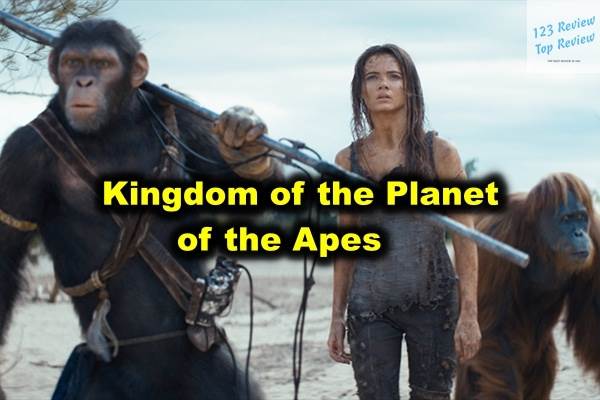Set generations after Caesar’s reign, the film highlights the challenges and triumphs of a new generation of leaders like Noa and Proximus Caesar. With stunning visuals and a compelling narrative, it examines themes of dominance, coexistence, and legacy. Directed by Wes Ball and written by Josh Friedman, the film offers fresh insights and sets the stage for future sequels.

In this article, 123 Review provides an in-depth look at the film’s timeline, characters, themes, plot, production insights, reception, and impact on the franchise.
Timeline and Setting
Overview of the Time Period Post-Caesar
“Kingdom of the Planet of the Apes” is set several generations after the death of Caesar, the legendary leader who unified the apes and led them to freedom from human oppression. The world has changed dramatically since Caesar’s time, with both apes and humans adapting to a new reality. The film portrays a society that is still deeply influenced by Caesar’s legacy, but also facing new and unique challenges as it evolves. The timeline is marked by a delicate peace, precariously balanced on the foundations Caesar built, but constantly threatened by the underlying tensions and ambitions of both species.
Changes in Ape-Human Dynamics
In the years following Caesar’s reign, the dynamics between apes and humans have undergone significant shifts. While Caesar’s vision of peaceful coexistence left a lasting impact, the road to harmony has been fraught with obstacles. Some ape communities have established thriving settlements, embracing a semblance of normalcy and peace. However, distrust and resentment persist in many quarters, leading to isolated skirmishes and political maneuvering. The film delves into these complex relationships, showcasing both the successes and failures in the ongoing effort to bridge the gap between apes and humans.
Major Locations in the Film
The film’s narrative unfolds across a variety of striking and symbolic locations. Key settings include:
- The Forest Sanctuaries: These dense, lush environments serve as the primary habitats for ape communities. Here, the apes live in a society reminiscent of their natural origins, maintaining a close connection to nature while developing their own cultural and social structures.
- Ruined Human Cities: These decaying urban landscapes, overgrown with vegetation and reclaimed by nature, stand as stark reminders of human civilization’s fall. They are both a source of resources and a battleground for control between surviving human factions and ape groups.
- Hybrid Settlements: New towns and villages where apes and humans attempt to live side by side. These settlements are microcosms of the broader societal tensions, offering a glimpse into the potential for cooperation and the challenges of overcoming deep-seated prejudices.
Characters and Species
Introduction of Noa and Mae
Two of the film’s central characters, Noa and Mae, represent the new generation of apes who have inherited Caesar’s legacy.
- Noa: A charismatic and intelligent leader, Noa is a direct descendant of Caesar. He embodies the qualities of leadership and wisdom that made Caesar a revered figure, but he also faces the daunting task of leading his people in an era of uncertainty. Noa is determined to uphold his ancestor’s ideals while forging a path that acknowledges the complexities of the current world.
- Mae: Serving as Noa’s closest advisor, Mae is a figure of empathy and strategic acumen. She understands both ape and human cultures deeply, having grown up in the hybrid settlements. Mae’s role is crucial in mediating conflicts and fostering understanding between the two species, making her an indispensable ally to Noa.
The Role of Proximus Caesar
Proximus Caesar, another descendant of Caesar, plays a pivotal role in the film. Unlike Noa, Proximus is more introspective and burdened by the weight of his lineage. He struggles with the expectations placed upon him and the desire to carve out his own identity. Proximus’s journey is one of self-discovery and acceptance, as he grapples with the legacy of his great ancestor and the pressing needs of his people. His character adds a layer of depth to the narrative, exploring themes of heritage, responsibility, and personal growth.
Supporting Characters in the New Era
The film introduces a rich cast of supporting characters who add depth and complexity to the story:
- Apex: A formidable ape warrior who questions Noa’s leadership and advocates for a more aggressive stance against humans.
- Elara: A human scientist working towards fostering better relations between the species, often caught between loyalty to her own kind and her belief in coexistence.
- Thorne: A human antagonist who leads a faction bent on reclaiming dominance over the apes, representing the darker side of human ambition and fear.
Each of these characters brings unique perspectives and conflicts to the narrative, enriching the film’s exploration of its central themes.
Themes and Motifs
Exploration of Dominance and Power
“Kingdom of the Planet of the Apes” delves deeply into the themes of dominance and power. The film examines how both apes and humans vie for control in a world where the balance of power is constantly shifting. Leadership is a central motif, with characters like Noa and Proximus navigating the complex dynamics of authority and influence. The struggle for power is depicted not just as a physical contest, but as a battle of ideologies and moral compasses, reflecting the nuanced nature of true leadership.
Coexistence of Species
A recurring motif in the film is the coexistence of apes and humans. Through various story arcs and character interactions, the film explores the challenges and possibilities of living together peacefully. It raises questions about tolerance, understanding, and the sacrifices required for true coexistence. The hybrid settlements serve as focal points for this theme, showcasing both the potential for harmony and the obstacles that must be overcome.
Legacy of Caesar’s Reign
Caesar’s legacy looms large over the narrative, influencing the actions and decisions of the characters. The film reflects on Caesar’s principles and the lasting impact of his leadership, highlighting the ongoing relevance of his vision in shaping the new world. Characters frequently reference Caesar’s teachings and use his legacy as a benchmark for their own actions, underscoring the enduring influence of his ideals.
Plot Development
Key Events Leading to Conflict
The film’s plot is driven by a series of key events that escalate tensions between apes and humans. These include:
- Territorial Disputes: As both species expand their territories, clashes over land and resources become inevitable, leading to skirmishes and diplomatic tensions.
- Resource Shortages: Scarcity of essential resources like food and water exacerbates existing conflicts, forcing characters to make difficult choices and alliances.
- Political Machinations: Within both ape and human societies, political maneuvering and power struggles create additional layers of conflict, as different factions vie for dominance.
These events set the stage for the film’s central conflict, pushing characters to their limits and revealing their true natures.
Climax and Resolution
The climax of the film sees a dramatic confrontation between the leading factions of apes and humans. This high-stakes battle tests the limits of both societies, forcing them to confront their deepest fears and prejudices. The resolution of the conflict is both poignant and hopeful, offering a glimpse of a possible future where mutual respect and cooperation prevail. However, the ending also leaves room for future conflicts, hinting at unresolved issues and the potential for new challenges.
Set-Up for Future Sequels
“Kingdom of the Planet of the Apes” expertly sets up potential storylines for future films. The ending hints at new adventures, challenges, and characters that will continue to explore the rich narrative landscape of the franchise. Loose ends and unanswered questions provide a fertile ground for subsequent installments, ensuring that the story remains dynamic and engaging.
Production Insights
Director Wes Ball’s Vision
Director Wes Ball brings a fresh and innovative perspective to the “Planet of the Apes” series. Known for his work on the “Maze Runner” series, Ball infuses the film with his distinctive visual style and storytelling approach. His vision combines the epic scope of the original films with a modern sensibility, creating a compelling and immersive cinematic experience. Ball’s direction emphasizes character development and thematic depth, ensuring that the film resonates on both an emotional and intellectual level.
Writing Contributions by Josh Friedman
Josh Friedman, renowned for his work on science fiction and action films, plays a key role in shaping the film’s screenplay. His contributions add depth and complexity to the narrative, balancing action sequences with thoughtful character development and thematic exploration. Friedman’s writing ensures that the film remains true to the spirit of the franchise while introducing new and intriguing elements.
Impact of Disney’s Acquisition of Fox
The impact of Disney’s acquisition of Fox is evident in the film’s production values and marketing strategy. The backing of Disney has allowed for a larger budget, more extensive special effects, and a broader promotional campaign. This has positioned “Kingdom of the Planet of the Apes” as a major cinematic event, attracting a wide audience and ensuring its success at the box office. The acquisition has also provided the franchise with new opportunities for cross-promotion and expansion within the broader Disney portfolio.
Reception and Impact
Critical Response from United States Audiences
Upon its release, “Kingdom of the Planet of the Apes” received a mixed to positive critical response in the United States. Critics praised the film’s visual effects, storytelling, and performances, particularly highlighting the new characters and the continuation of the franchise’s themes. The film was lauded for its ambitious scope and emotional depth, although some critics felt it struggled to match the groundbreaking impact of its predecessors.
Box Office Performance Analysis
The film’s box office performance reflected strong interest and anticipation, with impressive opening weekend numbers and steady ticket sales. “Kingdom of the Planet of the Apes” performed well both domestically and internationally, reaffirming the enduring popularity of the franchise. The film’s financial success has solidified its place as a major player in the modern cinematic landscape, ensuring that the series will continue to thrive.
Future of the Planet of the Apes Franchise
The positive reception and financial success of “Kingdom of the Planet of the Apes” have solidified the franchise’s future. Plans for sequels and spin-offs are already in the works, promising to expand the story and explore new aspects of the “Planet of the Apes” universe. The film’s success has also sparked renewed interest in the earlier films and related media, further cementing the franchise’s legacy in popular culture.
Legacy in the Sci-Fi and Action Genres
“Kingdom of the Planet of the Apes” has made a significant impact on the sci-fi and action genres. Its thoughtful exploration of complex themes, combined with groundbreaking visual effects and compelling storytelling, has set a new standard for franchise films. The film’s success demonstrates the continuing relevance and appeal of science fiction narratives that challenge audiences to think critically about society, power, and coexistence.
In conclusion, “Kingdom of the Planet of the Apes” is a worthy addition to the iconic franchise, offering a rich and nuanced exploration of its themes while setting the stage for future adventures. Its blend of action, drama, and thought-provoking storytelling ensures that it will be remembered as a landmark film in the series.





